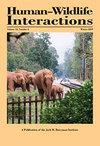One Step Closer to a Better Starling Trap
IF 0.9
4区 环境科学与生态学
Q4 BIODIVERSITY CONSERVATION
引用次数: 1
Abstract
European starlings (Sturnus vulgaris) are an invasive species in the United States that damage agriculture, personal property, and threaten human health and safety. The U.S. Department of Agriculture Wildlife Services provides technical support to mitigate damage by controlling starling populations at concentrated animal feeding operations, landfills, utilities, and urban areas. Wildlife Services uses DRC-1339, a registered toxicant, to reduce starling populations. Trapping can also be an effective tool but requires more time at a higher cost than DRC-1339. Trapping starlings, however, may be needed to provide a viable alternative to mitigate damage in areas where toxicant use may be restricted. To address this need, I developed a unique and effective starling trap to increase catch rates. I began testing multiple trap designs in November 2007 at cattle (Bos taurus) feedlots, meat processing plants, and urban staging areas in a 45-km radius of the city of Omaha, Nebraska, USA. In December 2011, I designed a 4-chamber, basket-style starling trap that has been instrumental in a nearly 90% reduction of the roosting starling population in downtown Omaha. Herein, I discuss the development and testing of the trap and provide guidelines and instructions for building and strategic placement of the trap.离更好的椋鸟陷阱又近了一步
欧洲椋鸟(Sturnus vulgaris)是美国的一种入侵物种,破坏农业、个人财产,威胁人类健康和安全。美国农业部野生动物服务部门提供技术支持,通过控制集中动物饲养场、垃圾填埋场、公用事业和城市地区的椋鸟数量来减轻损害。野生动物管理局使用DRC-1339,一种注册毒物,来减少椋鸟的数量。陷阱也可以是一个有效的工具,但需要更多的时间和更高的成本比DRC-1339。然而,可能需要诱捕椋鸟,以提供一个可行的替代方案,以减轻可能限制使用毒物的地区的损害。为了满足这一需求,我开发了一种独特而有效的椋鸟陷阱来提高捕获率。2007年11月,我开始在美国内布拉斯加州奥马哈市方圆45公里的牛饲养场、肉类加工厂和城市集散区测试多种陷阱设计。2011年12月,我设计了一个四室篮式椋鸟陷阱,在奥马哈市中心栖息的椋鸟数量减少了近90%。在这里,我将讨论陷阱的开发和测试,并为陷阱的构建和战略放置提供指导和说明。
本文章由计算机程序翻译,如有差异,请以英文原文为准。
求助全文
约1分钟内获得全文
求助全文
来源期刊

Human–Wildlife Interactions
Environmental Science-Nature and Landscape Conservation
CiteScore
2.80
自引率
0.00%
发文量
0
审稿时长
11 weeks
期刊介绍:
Human–Wildlife Interactions (HWI) serves the professional needs of the wildlife biologist and manager in the arena of human–wildlife conflicts/interactions, wildlife damage management, and contemporary wildlife management. The intent of HWI is to publish original contributions on all aspects of contemporary wildlife management and human–wildlife interactions with an emphasis on scientific research and management case studies that identify and report innovative conservation strategies, technologies, tools, and partnerships that can enhance human–wildlife interactions by mitigating human–wildlife conflicts through direct and indirect management of wildlife and increased stakeholder engagement. Our intent is to promote a dialogue among wildlife professionals concerning contemporary management issues. As such, we hope to provide a repository for wildlife management science and case studies that document and share manager experiences and lessons learned.
 求助内容:
求助内容: 应助结果提醒方式:
应助结果提醒方式:


